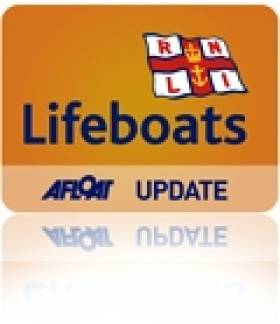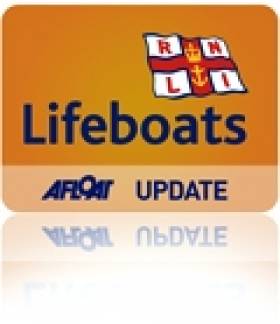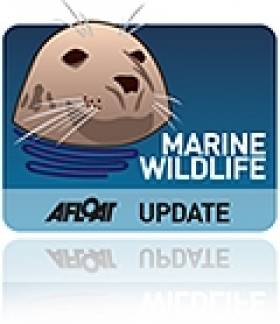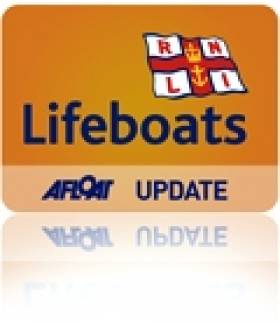Displaying items by tag: RNLI
#lifeboat – Lifeboat crew with Lough Derg RNLI launched this evening after eighteen rowing boats got into difficulty at Parker's Point. The rowers, who had set out from Terryglass, at the northern end of the lake, at 2pm, were en route to Killaloe when the weather deteriorated.
One rowing boat with five crew onboard remained unaccounted for and a major search and rescue operation was launched.
The lifeboat crew were stood down after the boat was found on Crow Island, and contact was made with the missing five rowers who had reached safety.
At 18.10hrs on Friday June 21 Valentia Coast Guard requested Lough Derg RNLI Lifeboat to launch to search for five people reported unaccounted for, after an international flotilla of eighteen rowing boats, many with a crew of five, got into difficulties in worsening weather near Parkers Point, at the southern end of Lough Derg.
The lifeboat launched at 18.20hrs with Helm Peter Clarke, Ger Egan and David Moore on board. Winds were westerly, Force 4, gusting 5, with poor visibility with rain and low cloud.
The lifeboat crew began search patterns alongside the Shannon based Coast Guard Helicopter, Killaloe Coast Guard, Limerick Rescue and Mount Shannon rescue and with three local boats. Lifeboat Medical Advisor Peter Hooker and RNLI crew member Dom Sharkey launched in another vessel to help with the search. It was known that of the five crew on the missing vessel, only the coxswain was wearing a lifejacket.
Information was hard to verify as rescuers worked to search the area. As boats were located, their crews were confirmed safe. It transpired that four boats had decided not to continue the journey and had returned to Terryglass, soon after they had set out earlier in the day.
At 21.40hrs, the remaining boat outstanding was eventually located, safely recovered on Crow's Island, north of Killaloe, however there was no sign of the missing crew. Shortly afterwards Gardai confirmed that the five rowers had made it to safety, and the search operation was stood down.
Commenting on the callout Eleanor Hooker Lough Derg RNLI Lifeboat Press Officer said, "This was an extremely challenging callout for all the search and rescue crews. With so many people to account for and so many vessels on the water it was quite a job to establish who was missing. The weather worsened on the lake quite rapidly, and the rowers rushed to get themselves to safety. In this instance the lifeboat crew joined with other agencies and local boats in a five hour search to locate the missing vessel. We are extremely relieved that there were no serious injuries."
Helm Peter Clarke advises boat users 'to check the weather forecast before setting out, to let others know where you are going and when you anticipate arriving, to always wear a lifejacket and to carry some means of communication in case of difficulties'.
The lifeboat returned to station and was ready for service again at 23.15hrs
Larne RNLI Rescues Unconscious Man From Lough
#RNLI - Larne RNLI rescued an unconscious man who was found a short distance from the shore at Larne Lough last night (Thursday 20 June).
The volunteer crew launched their inshore lifeboat Hannahbella Ferguson following a request by Belfast Coastguard at 10.35pm to go to the assistance of a person who was spotted lying face down in the sea within 200 metres from the shore in Larne Lough.
Weather conditions at the time were good with a flat calm sea but light was fading.
The lifeboat - helmed by Willie Evans and with crew members Dave Somerville and Pamela Dorman onboard - arrived on scene at 10.41pm and pulled the casualty on to the lifeboat. With the man not breathing, two crew members proceeded to perform CPR and resuscitated the casualty.
The helm brought the lifeboat into a small slipway along the promenade which was accessible due to a high tide. The casualty was subsequently handed over to the waiting paramedics and ambulance.
Speaking after the call-out, Larne RNLI helm Willie Evans praised the crew who he said had worked together to resuscitate the casualty and bring him to shore.
#RNLI - A fishing vessel with a fouled propeller was towed to safety by Wicklow RNLI this morning (21 June).
The volunteer crew launched their all-weather lifeboat at 10am following a report that a fishing vessel was in difficulty after a rope got fouled in its propeller.
The incident had echoes of Wednesday's rescue of a couple from their similarly fouled yacht off Arklow, as reported on Afloat.ie.
Wicklow RNLI's lifeboat crew located the drifting vessel was located by the lifeboat crew some six miles off Wicklow Head shortly after 10.30am.
A towline was quickly established and the boat was towed back to Wicklow harbour where it was safely secured alongside the south quay at midday.
Another fouling incident occurred further up the coast yesterday evening, as Skerries RNLI yesterday brought two people to safety after their motorboat got into difficulty.
The volunteer crew launched their inshore lifeboat on what was their second call out of the day shortly after 7pm following a report that a 29ft motorboat was in difficulty between Rogerstown Estuary and Lambay Island.
Weather conditions at the time were calm with a force one to two wind. Arriving on scene, the lifeboat – helmed by Willie Boylan – quickly located the motorboat which had lowered its anchor to wait for help to arrive.
Once it was established that the motorboat had fouled its propeller, a crew member was put on board the boat and a towline was established. The vessel was then brought safely back to Malahide Marina.
Speaking after the call-out, Skerries RNLI crew member Conor Walsh said: "Thankfully the crew had a VHF radio on board and were able to call for help. We were happy to assist and to be able to bring them and their boat safely to shore."
Whale Rescued In Meath Stranding Drama
#MarineWildlife - Skerries RNLI joined a number of groups in assisting a beached whale back out to sea at Gormanston in Co Meath earlier today (Thursday 20 June).
The volunteer lifeboat crew launched their inshore lifeboat shortly after 10am following reports from the Irish Whale and Dolphin Group (IWDG) that a 25ft pilot whale had beached in the area.
The lifeboat helmed by Joe May, and with crew members Emma Wilson, AJ Hughes and Laura Boylan onboard, made its way to the scene where May got into the sea and helped manoeuvre the whale back into deeper water.
Skerries RNLI then shadowed the whale guiding it out to sea, preventing it from turning back to shore by positioning the boat in its way. The lifeboat did this for about 25 minutes until the mammal was well clear of the shore.
Other agencies on scene included Skerries coastguard, the Defence Forces based at Gormanston, the IWDG, Boyne Fishermen’s Rescue and Irish Coast Guard helicopter Rescue 116.
Meanwhile, RTÉ News reports that a second whale was found dead on the beach near Mornington, north of Bettystown.
Despite initial fears that the whale was the same one rescued in the morning, it was later determined to be a different creature.
Arklow RNLI Rescues Couple From Yacht With Fouled Propeller
#RNLI - Arklow RNLI rescued a man and woman after their 12m yacht got into difficulty of the Wicklow coast yesterday afternoon (Wednesday 19 June).
The volunteer crew was requested to launch their all-weather lifeboat at 12.23pm following a report that a vessel was in distress four miles north of Arklow.
The man and woman on board the stricken vessel had been travelling from Scotland and were Arklow-bound on their journey home to Kent when they got into difficulty. Weather at the time was good.
Arriving on scene, the crew on board the lifeboat Ger Tigchelaar - under coxswain Ned Dillon - assessed the situation and observed that the vessel’s propeller had been fouled.
The stricken yacht’s crew had made efforts to clear the fouled lines. A tow line was quickly established and the vessel was towed safely back to Arklow.
Speaking after the call-out, Arklow RNLI volunteer lifeboat press officer Mark Corcoran said: "The man and woman on board the yacht this afternoon came into the lifeboat station to express their appreciation to the crew who were delighted to assist and to be able to bring them and their vessel safely to shore."
Crew members on board the lifeboat included coxswain Ned Dillon, mechanic Michael Fitzgerald, Brendan Dillon, Roger Tyrell and Andy O’Loughlin.
Three Fishermen Rescued After Boat Sinks off Donegal Coast
#rnli – Lough Swilly RNLI in county Donegal has assisted three fishermen this afternoon after their boat sank off the Inishowen peninsula.
The volunteer crew was requested to launch both their inshore and all weather lifeboats at 1.30pm following a report from the Marine Rescue Coordination Centre in Malin Head that a small fishing boat with three people on board had got into difficulty and was taking on water.
The boat subsequently sank off Fanad/Dunaff with the three men ending up in the water.
A local vessel which was in the area at the time rescued the men and transported them to the nearby Leenan Pier.
Arriving on scene, the lifeboat came alongside the vessel and a number of crew members went on board and administered first aid to the three men.
The fishermen were then airlifted by the Sligo based Irish Coast Guard helicopter and brought to Letterkenny General Hospital.
Arklow RNLI Hosts Summer Solstice Fundraiser
#RNLI - Arklow RNLI supporters are being asked to come out and walk or jog a midnight mile - four laps of the running track at Coral Leisure Centre - in Arklow this Friday 21 June.
The walk/run will take place on the Summer Solstice from 10pm. The event is free and all donations are welcome. Prize raffles will take place, and Stormy Stan and his lifeboat buddies will be on hand to cheer on the participants.
Participants are being asked to assemble at the Lake Coffee Shop in the leisure centre from 10pm, with the walk/jog commencing just before midnight.
Full details are available from Mary at 086 304 5418.
In other Arklow RNLI news, a former chairman of fundraising at the lifeboat unit was honoured recently by the charity for his trojan work recently.
Tommy Annesley, a local councillor, received the Bronze Award at the recent RNLI Annual Presentation of Awards at Trinity College Dublin.
A few days later, Annesley was again honoured, this time by his hometown and fellow councillors when he became Lord Mayor of Arklow.
All at Arklow RNLI including lifeboat crew, fundraisers and other volunteers extended their best wishes to Tommy Annesley for his tenure as Lord Mayor.
Meanwhile, at the recent RNLI AGM in London, Arklow RNLI operations manager Jimmy Tyrell made a presentation to current RNLI operations director Mike Vlasto to honour the relationship and friendship that has developed between them in their years in the RNLI.
- A unique handcrafted piece was made locally in Arklow for the presentation.
Both Tyrell and Vlasto are retiring from the RNLI over the next year.
Portaferry RNLI Rescue Two Men In Drifting Dory
#RNLI - Portaferry RNLI launched on Saturday afternoon 15 June to go to the rescue of a small craft which had lost power in Strangford Lough, Co Down.
The volunteer lifeboat crew was alerted at 1.10pm following a call that there was a 5m Dory drifting after its engine had failed.
The lifeboat - helmed by Simon Rogers and with crew members George Toma, Brendan Byers and Ryan Kelly onboard - was launched at 1.20pm and was alongside the stricken vessel just off Gransha Point at 1.34pm.
The weather at the time was a slight swell, light winds and good visibility.
Once alongside, the lifeboat crew found that the Dory was taking on water. The two men were taken onboard the lifeboat and the Dory was towed into Strangford Lough Yacht Club where the men were also left off.
#Surfing - Two national broadcasters will base themselves in Bundoran this week ahead of the Sea Sessions Surf Music Festival at the weekend.
Today FM’s KC Show will broadcast live from the Bundoran RNLI Lifeboat Station tomorrow 19 June and Thursday 20 June, while 2FM will broadcast from the Sea Sessions from Friday 21 to Sunday 23 June, giving the seaside town unprecedented national media coverage for five days.
As part of a recent Discover Ireland promotion on Today FM, listeners were asked where to send the various shows to on their holidays. Listeners to the KC Show had a choice of sending him to Dingle or Donegal and following thousands of votes, Donegal came out on top.
One of the locations suggested was Bundoran, and the RNLI Lifeboat station at the pier was chosen as the home for the KC Show for two daily broadcasts this week complete with live musical guests Walking With Cars and new Irish act Daithi.
No sooner will Today FM have packed up than the 2FM Roadcaster will be rolling into the Main Beach car park and preparing to broadcast from the Sea Sessions on Friday, Saturday and Sunday.
The national state broadcaster will give the festival unprecedented coverage with over 20 hours scheduled live from the beachfront. Jenny Greene, Cormac Battle, Ruth Scott and Paddy McKenna will all host their shows live across the weekend.
Bundoran tourism officer Shane Smyth commented: "I am thrilled that not one but two national broadcasters will be in town this week. It will be a welcome boost to the ongoing promotion of Bundoran as a destination.
"Speaking as Bundoran RNLI volunteer lifeboat press officer also, I’m obviously delighted that the RNLI will benefit from two days of national coverage and I know that KC and his team are keen to find out more about the lifeboat service here in Bundoran."
Smyth added: "The guys from 2FM had a great time when they were here a few weeks ago and we look forward to welcoming them again over Sea Sessions weekend. Last time they were here they brought scorching sunshine with them – let’s hope they do the same again!”
Sea Sessions is Ireland's "biggest and best" surfing and music festival and returns for its sixth successive year in 2013. Based in Bundoran, the festival also includes surf tour events in Lahinch, Co Clare and nearby Sligo.
Galway Windsurfers Set Paddle Board Record
#Surfing - A trio of Galway windsurfers completed the 95km round trip to and from the Aran Islands last weekend - setting a new Irish record for stand-up paddle boarding in the process.
The Irish Times reports on the successful adventure by Dan Gardner, Daniel King and Joe Gallagher, who embarked on the challenge to raise funds for the Galway RNLI lifeboat service.
Setting out before 5.30am on the morning of Saturday 8 June, they returned to the Galway Docks before 11pm that night - stopping at the halfway mark for lunch on Inis Mór.
The trio are each believed to have covered some 4,000 strokes an hour to make their record time of 17 hours 33 minutes. The Irish Times has more on the story HERE.
In other surfing news, the Sunday Independent reports on a website that's seeking to connect surfers of all levels with the right waves for them.
Waterford-based Liam Sinnott set up Swellseekers.ie with business partner James Hassey two years ago, filling a gap in the market for booking surfing trips online at a time when Ireland was only just emerging as a world-class surfing destination.
Though the site currently only takes bookings for surfing and other watersports in the Waterford area, Sinnott says he hopes to expand his site's scope nationwide by next year to serve a growing wave-riding community of "50,000 surfing all year round".






































































